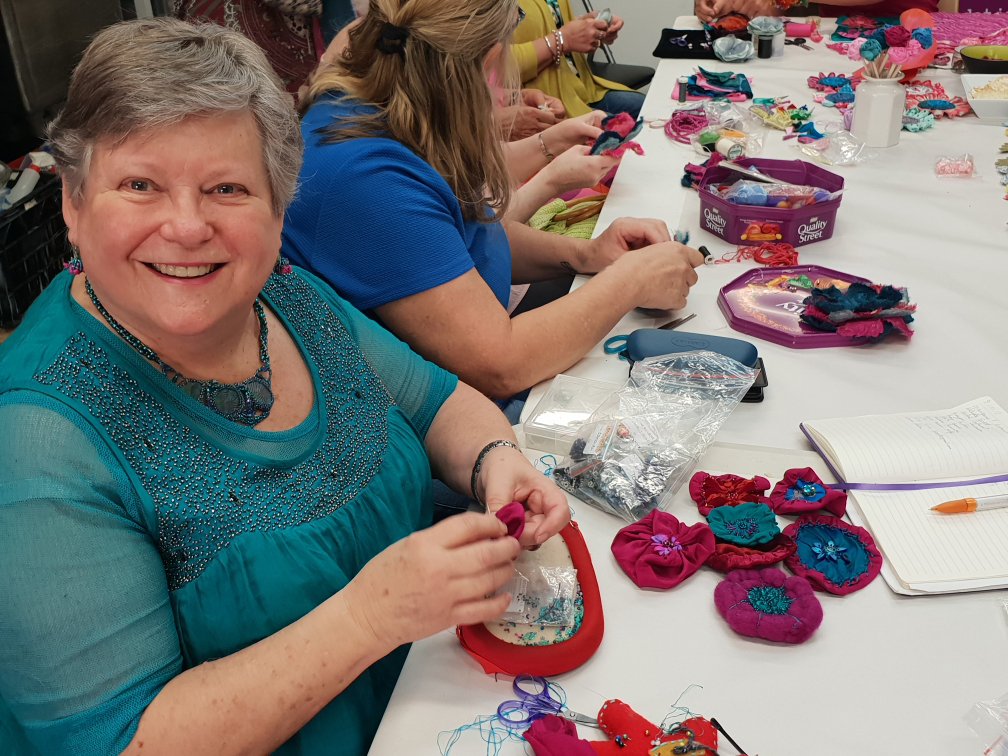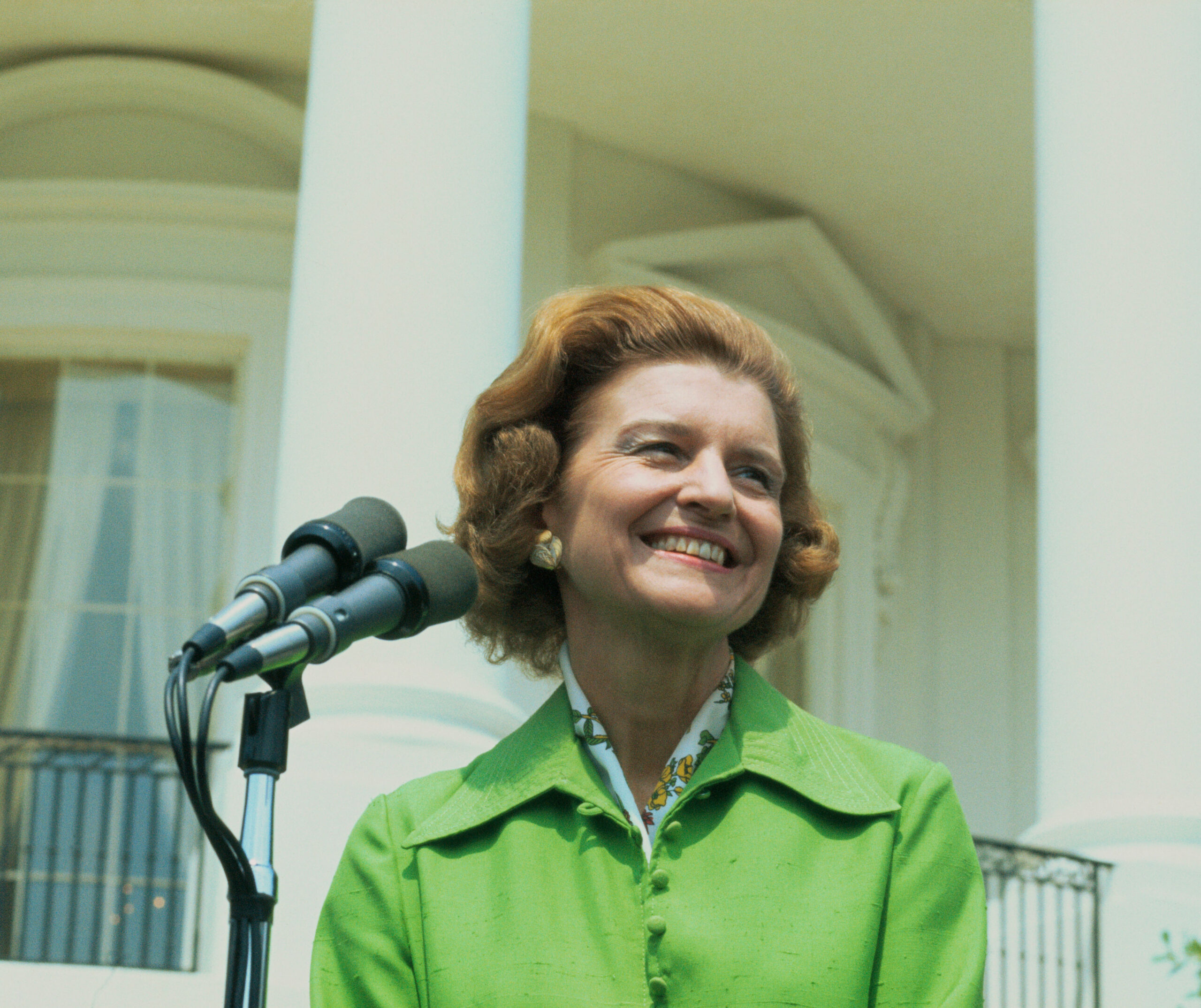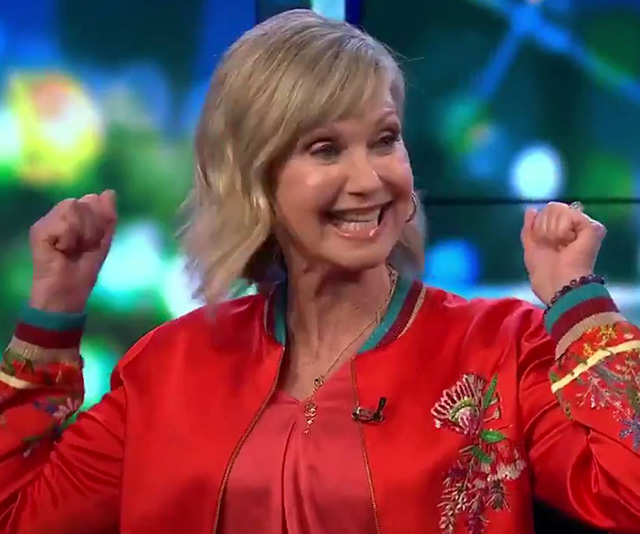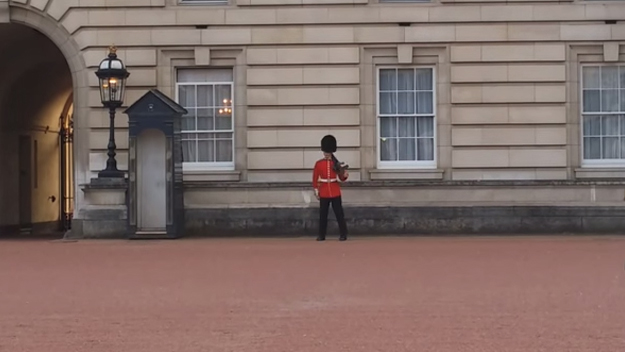I first met Jill Emerson late last year in a room behind an old heritage-listed art gallery in the NSW port town of Newcastle.
Dozens of women were gathered around a long table, chattering brightly as they sewed silk and cotton flowers.
Only two colours were used in their creations: the pink of the breast cancer awareness campaign and the teal of the ovarian cancer movement.
Their conversations stopped, but their work didn’t, as the woman they were sewing for entered.
At 60, Jill was dignified, warm, vibrant, and hiding the pain in her body, as she addressed the group about saving the lives of women with ovarian cancer.
“It takes numbers – more women asking for change, demanding change,” Jill insisted.
But there the problem lies, because ovarian cancer is so lethal that not enough women survive to raise the awareness and research funding that could significantly improve outcomes.
Which is why Jill – a broadcaster, wife mother and committed activist – resolved to bring together the pink and the teal, the breast cancer and the ovarian cancer awareness movements.
“By working together we can make a difference,” she said determinedly.
She knew she had little time but she had resolved to use all she had left to improve the odds for other women confronting ovarian cancer.
Jill had a passionate nature and an engaging manner. As we spoke in a sun-drenched courtyard that afternoon, there were few outward signs she had terminal cancer.
But within months of our interview, Jill died, tragically fulfilling the prophecy she was fighting to change.

Jill (right) and her daughter, Malia, at her wedding to Ken, to whom she proposed after having brain surgery.
(Credit: Photography by Alex Jack.)An accidental advocate
Jill’s quest began in February 2016 when she went to the doctor about a persistent “dragging” sensation in her vagina that had escalated into a sort of “electric twinge”.
She was busy at work and not particularly worried. Nevertheless, she made an appointment with her GP. She was experiencing a pleasant phase of calm in her life.
She was a morning presenter at ABC local radio in Newcastle and, after being a single mother for many years, she had been dating a kind man named Ken Lambert who had changed her life.
“I’d been on my own for a very long time,” she said. She was in love.
After explaining her symptoms to her doctor, Jill was sent for a transvaginal ultrasound. Her blood test results suggested she may have ovarian cancer, but in order to be certain, she had to have surgery.

A fellow activist creating rosettes for the gala.
(Credit: Photo supplied.)A gynaecological oncologist opened her up, confirming the worst. Jill had advanced stage three ovarian cancer.
“I was just devastated,” she said.
One of the reasons ovarian cancer is so deadly is that it’s so hard to detect. It spreads like grains of sand, washing through the body. Its nickname is the disease that whispers.
“It runs everywhere,” Jill explained.
“It will get out of your ovaries and it will scatter. Then it will attach itself to another organ. Mine was already metastasised. That’s what seals your fate really. If it’s already on another organ the chances of being able to contain it are really small.”
The surgery required to diagnose ovarian cancer is colloquially known as peek and shriek.
“Because they’d open you up, have a look and then they’d scream because it was so far gone,” Jill said.
Even her partner, Ken, a GP, was surprised by the diagnosis.
“The early symptoms are so vague,” she added.

Jill with D-Majors choice founder Lauren O’Brien.
(Image: Supplied)Before Jill’s diagnosis had been confirmed, she had to sign a waiver that gave her surgeon permission to cut her up to her chest, in case the cancer had spread.
When the surgeon investigated, he found Jill’s body was riddled with cancerous cells.
A pathologist confirmed the diagnosis, and then the surgeon began the process known as “de-bulking”, which means excising the organs that have been infiltrated.
Jill went into the operating theatre wondering if her fears of cancer would be confirmed. She came out without her uterus, ovaries and fallopian tubes.
“It was horrific,” she says.
Despite this drastic removal of so many body parts, her surgeon could still only give Jill a 50/50 change of survival.
When she was well enough, Jill went in search of answers.
She zig-zagged all over the country, attending conferences and visiting clinicians, acting on her journalist’s instinct to gather as much information as she could.
Her sister, Judy-Ann Emberson, said what Jill discovered were “terrible, ordinary facts”.
WATCH BELOW: Olivia Newton-John speaks about living with her stage 4 cancer. Article continues after video.
“The more I learnt, the madder I got,” Jill explained on her podcast Still Jill. Ovarian cancer is classified as a “rare” cancer. Rare cancers cause about half of all cancer deaths but receive only 12 per cent of research funding.
That can’t be right, Jill thought. Years of reading about progress in the fight against cancer has lulled us all into the belief that the ‘big C’ is no longer a death sentence.
Cervical cancer will be wiped out by 2020. Breast cancer’s five-year survival rate is 91 per cent.
But advancements are not unilateral. ‘What’s being done for women with ovarian cancer?’ she wanted to know. The answer: very little.
Jill began chemotherapy. She lost her hair, but she wasn’t “too debilitated”. She felt determined and defiant.
As she left the hospital after the final day of chemo, relief coursed through her veins.
“I thought I was going to be in that group that sails through this,” she said.
But ovarian cancer’s relapse rate is high. About three-quarters of women diagnosed with advanced stage ovarian cancer have a recurrence within 12 to 24 months of completing their initial treatment.
Nine months after her last round of chemo, Jill got the call she had been dreading. The cancer was back, and it was incurable. On hearing the news, Jill fell on the floor. Ken got down onto the ground with her.
After living her life as a virtuoso for so long, Ken’s act of love was “a very different texture” from the type of love she had experienced for most of her adult life. She let him hold her.
“I’d tipped out of the world of surviving into the world of being taken by this disease,” she explained. Yet, in time she rallied.

In 2015, 1365 new cases of ovarian cancer were diagnosed in Australian women. The five year survival rate for ovarian cancer is 45%, according to Cancer Council Australia.
(Credit: Getty Images)The power of love
In a bid to understand how ovarian cancer research had been overlooked, Jill delved into the history of cancer advocacy.
“Back in the ’60s the standard treatment for breast cancer was cutting both breasts off, taking the lymph nodes, the works,” Jill said.
A turning point came when a US journalist named Rose Kushner spoke out about the treatment.
She refused to have her breasts cut off and began questioning the status quo.
“Conventional practice started to change,” Jill said.
When former American First Lady Betty Ford spoke publicly about her breast cancer diagnosis, it resulted in a spike of tests, which came to be known as The Betty Ford Blip.
“As the wife of a President, she was able to really get a big audience,” Jill said.
“When I read that sort of stuff, I thought, ‘These are just individual women. I can do something like that. It hasn’t taken rocket science. It has taken women to say what they think.'”

The Pink Meets Teal rally in Newcastle, Jill in the front row.
(Credit: Photo supplied.)The problem for ovarian cancer sufferers, Jill learned, is a cruel Catch-22.
“We literally don’t live long enough to form the army of advocates,” she said.
This was something she was told by researchers at the Peter MacCallum Cancer Centre in Melbourne when she went there seeking answers.
“The researchers literally said to me: ‘You need an army of advocates like breast cancer and you just don’t stay alive long enough’. I heard it from clinicians’ mouths.”
A further complicating factor, Jill believed, was the sense of shame attached to women’s reproductive cancers.
“There’s clear evidence women can go to their doctor three or four times before they get a satisfactory diagnosis,” Jill says.
“Doctors say that is also because women are embarrassed to talk about their own reproductive organs. I think that’s reflected in the public arena.”

Bella McGavin singing at Pink Meets Teal.
(Credit: Photo supplied.)In September 2017, Jill woke with a splitting headache. When she tried to get out of bed, she fell to the floor. Ken called an ambulance, which rushed Jill to hospital, where doctors performed emergency surgery.
The cancer had spread to her brain. Ken spent an anxious night by her side, wondering if she’d ever wake again.
Jill did, and she’d had a revelation. She realised Ken had saved her life, and was much more than a boyfriend. As she lay in the hospital bed, recovering from brain surgery, she asked him if he would marry her.
She laughed as she spoke about it, but the answer was not the one for which she’d hoped. As a doctor, Ken felt he couldn’t say yes to a proposal made in the aftermath of brain surgery.
“It was an amazing mix of feelings,” Ken confessed when Jill interviewed him on Still Jill.
He was proud Jill wanted to marry him, but “another part of me kicked in, the medical part, and that part of me said: this beautiful partner of mine, that I’m so blown away by, what she’s just said, she’s within 12 hours of major surgery.”
WATCH BELOW: Professors Bill Wilson and Bill Denny explain what the cancer lab does. Story continues below.
So, even though it “sort of broke my heart”, he turned her down with the proviso that, if she still felt the same way in a few weeks, he’d reconsider.
Jill’s wishes didn’t change. She told him she meant every word, and they began to plan their wedding. A local dressmaker created a gown for Jill, embellishing it with hundreds of beaded flowers.
When the day came, her daughter Malia Emberson-Lafoa’i walked Jill down the aisle in a celebration of life and love.
“It was a show,” Jill said, smiling. “One friend said the wedding was so good she would have bought a ticket.”
Then came another coup. Jill was invited to address the National Press Club in Canberra. Preparing for the speech, she knew she had to come up with some practical ideas.
“You can do those speeches and people say: but what do I do? And I thought: wouldn’t it be great if the breast cancer organisations and the teal organisations could get together and do something together.”
Her idea got a round of applause. It hit a nerve.
“I followed that up by saying: all you breast cancer organisations, you’ll be hearing from me.”
Jill founded Pink Meets Teal, which calls for funding fairness across all women’s cancers, particularly ovarian.
Ovarian cancer kills one Australian woman every eight hours, yet its five-year survival rate of only 46 per cent has barely improved in 20 years.
It’s not as common as breast cancer, but is far more deadly. What breast cancer sufferers have is an army of survivors – a powerful force Jill wanted to harness.
The pink in the sewing room where we first met signified the sisterhood Jill fostered between breast cancer survivors and ovarian cancer sufferers. For a long time, she felt like it was a cause she was championing on her own.
But in her home city of Newcastle, a cancer survivor choir called the D-Majors threw their might behind her mission. The choir’s founder, Lauren O’Brien, heard what Jill was doing and asked the “girls’ army”, as she calls the D Majors, to help.
“They just stepped right up and asked what can we do?” Lauren says.

Jill and Ken walk up the aisle at their wedding, newly made man and wife.
(Credit: Photography by Alex Jack.)Jill was at home when she heard an unfamiliar sound and went to her balcony to investigate.
“The next thing I hear, coming down my drive …” Jill hummed a little of their tune.
The D Majors were pouring into her yard and raising their voices in a show of strength and love. The song they’d chosen was ‘Lean on Me’.
“It was incredible,” Jill said, a tear in her eye. “It’s a small initiative in a small town but that can grow.”
A former Greenpeace activist, and ABC journalist, Jill had raised her daughter as a single mother and had never been one to back away from a fight.
She made tremendous strides. Her direct advocacy in Canberra helped secure $35 million for ovarian and other gynaecological cancer funding from the federal government.
“I’m just kicking myself that I’ll be going before we have time [to make a real difference],” she said quietly.
But there’s still no test and no cure, so she was determined to keep up the fight.
With her ‘think globally, act locally’ philosophy, Jill called the seamstress who had made her wedding dress and she immediately went to work sewing 30 specially designed dresses. The top was pink, the bottom, teal.
On May 8 last year, for World Ovarian Cancer Day, Jill and her phalanx of supporters gathered on the main street of Newcastle in a colourful call for better funding. They launched a petition that has attracted 45,000 signatures and is growing. Even now, her campaign is gathering traction.

Former American First Lady Betty Ford was open about her breast cancer diagnosis and had had a mastectomy in 1974, weeks after taking on the title of First Lady. Her openness about her cancer and treatment raised the visibility of a disease that Americans had previously been reluctant to talk about.
(Credit: Getty Images)Women are flocking to Pink Meets Teal’s social media pages. One breast cancer survivor who now has ovarian cancer wrote a testimonial to the importance of what Jill is doing: “When I went through treatment with breast cancer, I had so much support from breast cancer nurses, I was never really frightened.”
“I’m stage 4 OC [Ovarian Cancer]. The support I’ve received I’ve had to find, there never seems to be everyday support unless I seek it out. I think we need not only more funding for research, but funding for OC nurses as well.”
One of the cruellest things about ovarian cancer is that it can leave sufferers feeling isolated and lonely. Pink Meets Teal works to change that.
“Ovarian cancer women say, ‘I feel so touched and uplifted by this’,” Jill told me.
A vital legacy
After her second round of chemo failed, Jill was offered a place in an immune-therapy trial but “it stopped working” just before we met.
“At first I was like: I’m going to beat this disease. Now, I’m living proof of what I’ve said all along: We die quickly,” she said.
“We can’t keep taking small steps forward, but I now see why we only make small steps.”
“I’m one of the 1500 diagnosed in Australia each year. Okay, I’ve managed to make a difference but I wish there were five of me. I didn’t want to be this person, to grow up to be an ovarian cancer campaigner.”
It’s a story without a happy ending. For all her spirit and guts, Jill couldn’t stop the disease from advancing. She was too ill to attend a Pink Meets Teal gala last November. In her absence, the organisation she started raised $30,000 for ovarian cancer research.
Two weeks later she died peacefully with Malia holding one hand, Ken holding the other.
It was as she had predicted: another loud voice shouting about the disease that whispers had been silenced.
Yet her legacy lives on. Jill inspired supporters across Australia. She leaves behind an army. Thanks to her tireless devotion and strength, other women may one day be spared her cruel fate.
To support Pink Meets Teal, follow the organisation on Facebook and sign the petition at change.org.
Purchase a Teal Ribbon or donate on Teal Ribbon Day, February 26.



.png)